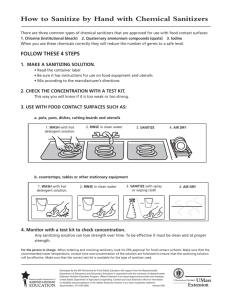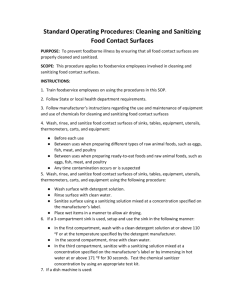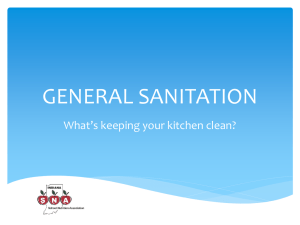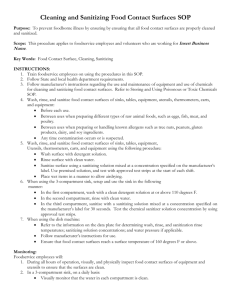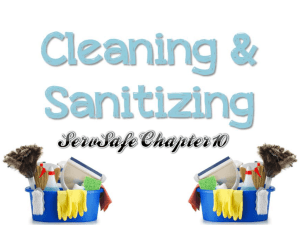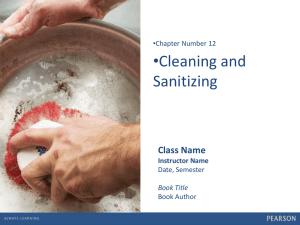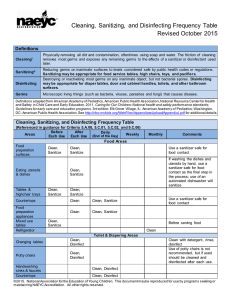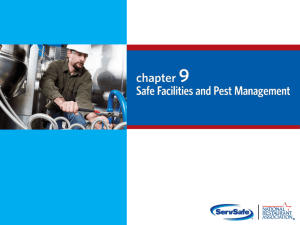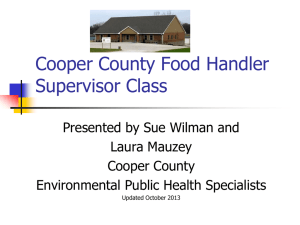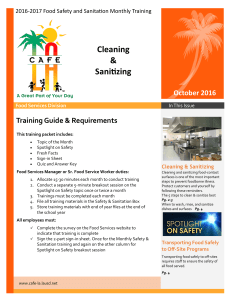How and When to Clean and Sanitize
advertisement
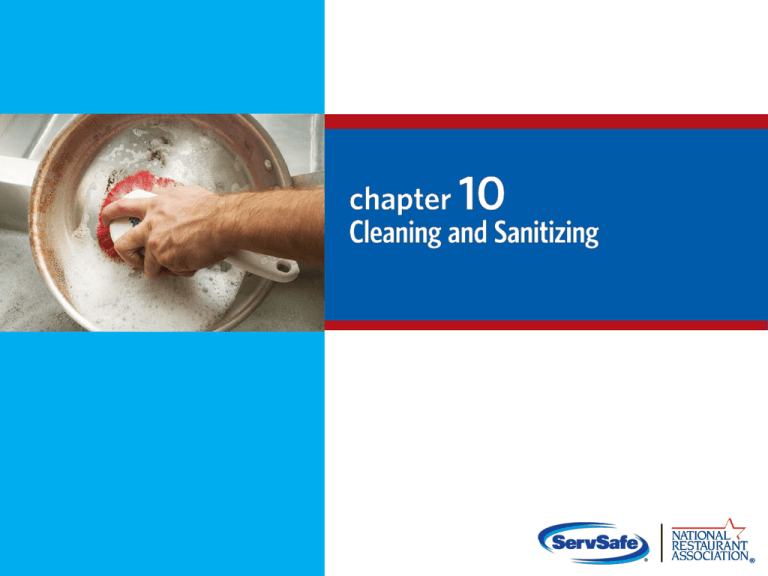
DVD 10-2 Additional Content 10-3 Guidelines for the Effective Use of Sanitizers Chlorine Water temperature Water pH Water hardness Sanitizer concentration range Sanitizer contact time 10-4 ≥100°F (38°C) ≥75°F (24°C) ≤10 ≤8 As per manufacturer’s recommendations 50–99 ppm 50–99 ppm ≥7 sec ≥7 sec Guidelines for the Effective Use of Sanitizers Water temperature Water pH Water hardness Sanitizer concentration range Sanitizer contact time 10-5 Iodine Quats 68°F (20°C) 75°F (24°C) ≤5 or as per manufacturer’s recommendations As per manufacturer’s recommendations As per manufacturer’s recommendations ≤500 ppm or as per manufacturer’s recommendations 12.5–25 ppm As per manufacturer’s recommendations ≥30 sec ≥30 sec How and When to Clean and Sanitize How to clean and sanitize: 1. Scrape or remove food bits from the surface 2. Wash the surface 4. Sanitize the surface 10-6 3. Rinse the surface 5. Allow the surface to air-dry How and When to Clean and Sanitize Cleaning and sanitizing stationary equipment: Unplug the equipment Take the removable parts off the equipment o 10-7 Wash, rinse, and sanitize them by hand or run the parts through a dishwasher if allowed Scrape or remove food from the equipment surfaces Wash the equipment surfaces How and When to Clean and Sanitize Cleaning and sanitizing stationary equipment: Rinse the equipment surfaces with clean water Sanitize the equipment surfaces o 10-8 Make sure the sanitizer comes in contact with each surface Allow all surfaces to air-dry Put the unit back together How and When to Clean and Sanitize Clean-in-place equipment: 10-9 Equipment holding and dispensing TCS food must be cleaned and sanitized every day unless otherwise indicated by the manufacturer Check local regulatory requirements Manual Dishwashing Setting up a three-compartment sink: 10-10 Clean and sanitize each sink and drain board Fill the first sink with detergent and water at least 110°F (43°C) Fill the second sink with clean water Fill the third sink with water and sanitizer to the correct concentration Provide a clock with a second hand to let food handlers know how long items have been in the sanitizer Cleaning and Sanitizing in the Operation Cleaning up after people who get sick: Diarrhea and vomit in the operation must be cleaned up correctly o 10-11 It can carry Norovirus, which is highly contagious Correct cleanup can prevent food from becoming contaminated and keep others from getting sick Cleaning and Sanitizing in the Operation Consider the following when developing a plan for cleaning up vomit and diarrhea: 10-12 How you will contain liquid and airborne substances, and remove them from the operation How you will clean, sanitize, and disinfect surfaces When to throw away food that may have been contaminated What equipment is needed to clean up these substances, and how it will be cleaned and disinfected after use When a food handler must wear personal protective equipment Cleaning and Sanitizing in the Operation Consider the following when developing a plan for cleaning up vomit and diarrhea: 10-13 How staff will be notified of the correct procedures for containing, cleaning, and disinfecting these substances How to segregate contaminated areas from other areas When staff must be restricted from working with or around food or excluded from working in the operation How sick customers will be quickly removed from the operation How the cleaning plan will be implemented Cleaning and Sanitizing in the Operation NEVER: 10-14 Dump mop water or other liquid waste into toilets or urinals Clean tools in sinks used for o Handwashing o Food prep o Dishwashing Review 10-15 Review Should it be cleaned and sanitized? A. Yes B. No 10-16 Review Should it be cleaned and sanitized? A. Yes B. No 10-17 Review What are the steps for cleaning and sanitizing a prep table? 10-18 1. Scrape or remove food from the surface 2. Wash the surface 3. Rinse the surface 4. Sanitize the surface 5. Allow the surface to air-dry Review Jorge has used the same knife and cutting board to prep tomatoes for over an hour. Should he clean and sanitize them? A. Yes B. No 10-19 Review Bob finished trimming a roast and wants to use the same knife and cutting board to prep fish. Should he clean and sanitize them? A. Yes B. No 10-20 Review What two methods can be used to sanitize surfaces? 10-21 1. Heat sanitizing 2. Chemical sanitizing Review What temperature must the water be when using heat sanitizing? 10-22 At least 171°F (77°C) Review What factors influence the effectiveness of a sanitizer? 10-23 Concentration Water temperature Contact time Water hardness Water pH Review What should the temperature be for the final sanitizing rinse in a dishwashing machine? 10-24 At least 180°F (82°C) At least 165°F (74°C) for stationary rack single-temperature machines Review Are these stored correctly? A. Yes B. No 10-25 Review How should chemicals be stored? 10-26 In their original containers Away from food and prep areas Separated by spacing or partitioning
